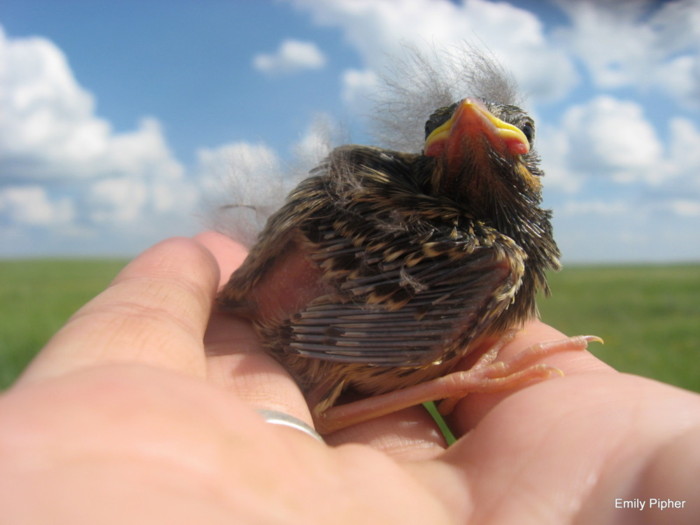
A Savannah sparrow chick, a host species U of M researchers discovered are being parasitized by the brown-headed cowbird at a high rate. // Photo: Emily Pipher, U of M graduate student
Birds in Alberta oil fields forced to raise imposters at alarming rate
Alberta’s oil and gas infrastructure is providing a great living to the brown-headed cowbird, a bird species that tricks other songbirds into raising its young, a new University of Manitoba study finds.
Prairie songbirds, already struggling to cope with habitat fragmentation and degradation caused by agriculture and industrial development, are now facing the stress of this parasitic bird, which sneaks its eggs into host species’ nests.
Nicola Koper, a professor in the Natural Resources Institute at the University of Manitoba, worked with her graduate students Jacy Bernath-Plaisted and Heather Nenninger on the study that was just published in Royal Society Open Science. They report that the presence of oil and gas infrastructure, such as wells, roads and power lines, has lead to a four-fold increase of brown-headed cowbirds in pastures with oil wells or natural gas compressor stations, probably because the birds use these as perch sites to seek out nests to parasitize.
“This increase in cowbird abundance led to dramatic increases in parasitism of nests,” says Koper. “I was shocked at how large the impact was.”
Brood parasitism has a variety of negative effects on a songbird nest: increased risk of nest abandonment by the parent, increased hatchling failure, songbird hatchlings being outcompeted for food by the bigger imposter, and higher predation rates, possibly because the newly hatched cowbirds are attractively loud.
Given that parasitized Savannah sparrow nests at her study sites suffered, Koper’s paper warns that this increase in parasitism pressure might hurt regional populations of this species. But there are solutions.
Koper’s paper suggests that industry can mitigate this by reducing perch sites the cowbirds use. For instance, power lines could be buried, and future wells can be constructed in locations that minimize the need for new roads.
“Our society is going to be dependent on fossil fuels for many more decades,” says Koper, “but we can use these resources in ways that reduce their impacts on the environment.”
Koper’s study was supported by Cenovus Energy, Canadian Foundation for Innovation, Manitoba Research and Innovations Fund, Clayton H. Riddell Endowment Fund of the University of Manitoba, and the Natural Sciences and Engineering Research Council.






